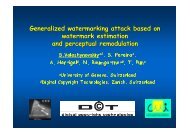SPREAD SPECTRUM WATERMARKING FOR REAL IMAGES: IS IT ...
SPREAD SPECTRUM WATERMARKING FOR REAL IMAGES: IS IT ...
SPREAD SPECTRUM WATERMARKING FOR REAL IMAGES: IS IT ...
Create successful ePaper yourself
Turn your PDF publications into a flip-book with our unique Google optimized e-Paper software.
lowing simplifications: spectral range [ω ′ ; π] is divided on<br />
10 3 (π-ω ′ ) non-overlapping intervals covering Ω. It is assumed<br />
that power spectral density of the host image is flat<br />
on each interval and its value is determined by left interval<br />
boundary.<br />
The results of performed experiments are presented in<br />
Fig. 6.<br />
DC-DM<br />
DM<br />
(a)<br />
DC-DM<br />
DM<br />
Figure 6: Capasity analysis: khown-host-state versus khownhost-statistics<br />
watermarking of real images: (a) WIR=-16 dB<br />
and (b) WIR=-6 dB.<br />
The obtained experimental results show how significantly<br />
SS watermarking performance can be improved using model<br />
based embedding. As a reference we use the crossing point<br />
of the capacity plots of the SS and the DC-DM and the OSS<br />
and DC-DM. In the the case of WIR=-16 dB this point is<br />
moved from -10 dB to -2 dB and from -4 db to 4 dB in case<br />
of WIR=-6 dB.<br />
Therefore, modified embedding in the OSS allows to enchance<br />
the performance of the classical SS on 8 dB in each<br />
case.<br />
4. CONCLUSIONS<br />
In this paper we present one of several possible improvements<br />
of classical spread spectrum watermarking under<br />
AWGN attack. Motivated by the superior practical performance<br />
of the state-of-the-art watermarking technology that<br />
is based on SS principle, our approach consists in modifying<br />
the watermark power spectrum depending on the power<br />
spectrum of the host. In this situation, when the host image<br />
is modeled as the AR(1) process, we show the solution of<br />
the optimal watermark power allocation problem. The developed<br />
data-hiding method called optimized SS watermarking<br />
illustrates a significant performance enhancement over classical<br />
known-host-statistics methods.<br />
5. ACKNOWLEDGMENTS<br />
This paper was partially supported by the Swiss SNF grant<br />
No 21-064837.01, SNF Professorship grant No PP002-<br />
68653/1, the CTI-CRYMEDA-SA and Interactive Multimodal<br />
Information Management (IM2) projects. The authors<br />
are thankful to Jose Vila, Emre Topak and Yuriy<br />
Rytsar for many helpful and interesting discussions. Special<br />
thanks are to J. Eggers (Siemens former University of<br />
Erlangen-Nürnberg) for many interesting discussions about<br />
the SCS and corresponding capacity results of performance<br />
of quantization-based schemes.<br />
(b)<br />
REFERENCES<br />
[1] B. Chen and G. W. Wornell. Quantization index modulation:<br />
A class of provably good methods for digital watermarking<br />
and information embedding. IEEE Trans.<br />
on Information Theory, 47:1423–1443, May 2001.<br />
[2] M. Costa. Writing on dirty paper. IEEE Trans. on Information<br />
Theory, 29(3):439–441, May 1983.<br />
[3] T. Cover and J. Thomas. Elements of Information Theory.<br />
Wiley and Sons, New York, 1991.<br />
[4] I. Cox, J. Killian, T. Leighton, and T. Shamoon. Secure<br />
spread spectrum watermarking for images, audio<br />
and video. In Proceedings of the IEEE Int. Conf. on<br />
Image Processing ICIP-96, pages 243–246, Lausanne,<br />
Switzerland, 1996.<br />
[5] J. Eggers, J. Su, and B. Girod. Performance of a practical<br />
blind watermarking scheme. In Proc. SPIE Security<br />
and Watermarking of Multimedia Contents 01, San<br />
Jose, CA, January 2001.<br />
[6] M.H. Hayes. Statistical Digital Signal Processing and<br />
Modeling Programming. Wiley, New York, 1996.<br />
[7] A. L. Jain. Fundamentals of Digital Image Processing.<br />
Prentice-Hall, 1989.<br />
[8] S. Mallat. A theory for multiresolution signal decomposition:<br />
the wavelet representation. IEEE Trans. on<br />
PAMI, 11:674–693, 1989.<br />
[9] P. Moulin and M. K. Mihcak. A framework for<br />
evaluating the data-hiding capacity of image sources.<br />
IEEE Trans. on Image Processing, 11(9):1029–1042,<br />
September 2002.<br />
[10] F. Perez-Gonzlez, F. Balado, and J. R. Hernndez. Performance<br />
analysis of existing and new methods for data<br />
hiding with known-host information in additive channels.<br />
IEEE Trans. on Signal Processing, Special Issue<br />
on Signal Processing for Data Hiding in Digital Media<br />
and Secure Content Delivery, 51(4), April 2003.<br />
[11] F. A. P. Petitcolas. Stirmark 3.1. 1999. http://<br />
www.cl.cam.ac.uk/ fapp2/watermarking/stirmark31/.<br />
[12] J. K. Su, J. J. Eggers, and B. Girod. Analysis of digital<br />
watermarks subjected to optimum linear filtering<br />
and additive noise. Signal Processing, Special Issue on<br />
Information Theoretic Issues in Digital Watermarking,<br />
81(6):1141–1175, 2001.<br />
[13] S. Voloshynovskiy, F. Deguillaume, O. Koval, and<br />
T. Pun. Robust watermarking with channel state estimation,<br />
part I: Theoretical analysis. Signal Processing,<br />
page Accepted for publication, 2004.<br />
[14] S. Voloshynovskiy, F. Deguillaume, O. Koval, and<br />
T. Pun. Robust watermarking with channel state estimation,<br />
part II: Applied robust watermarking. Signal<br />
Processing, page Accepted for publication, 2004.<br />
[15] S. Voloshynovskiy, A. Herrigel, N. Baumgaertner, and<br />
T. Pun. A stochastic approach to content adaptive digital<br />
image watermarking. In Third International Workshop<br />
on Information Hiding, volume 1768, pages 212–<br />
236, Dresden, Germany, Sept. 29 - Oct. 1st 1999.






